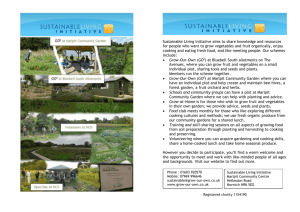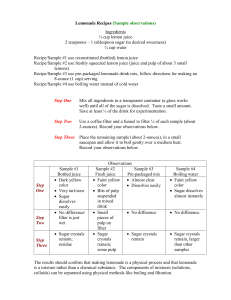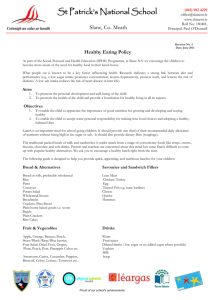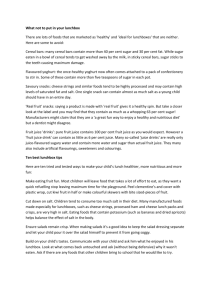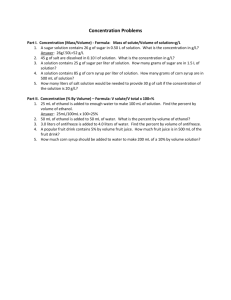Fruit Butters (SP 50-304) - Oregon State University Extension Service
advertisement
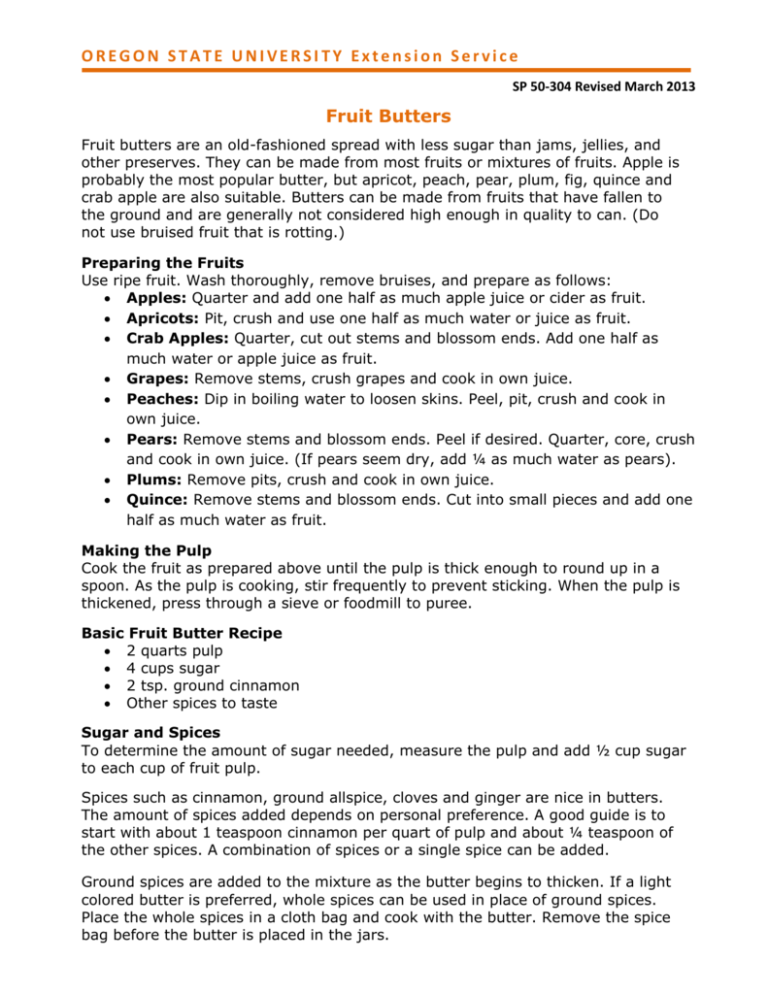
OREGON STATE UNIVERSITY Extension Service SP 50-304 Revised March 2013 Fruit Butters Fruit butters are an old-fashioned spread with less sugar than jams, jellies, and other preserves. They can be made from most fruits or mixtures of fruits. Apple is probably the most popular butter, but apricot, peach, pear, plum, fig, quince and crab apple are also suitable. Butters can be made from fruits that have fallen to the ground and are generally not considered high enough in quality to can. (Do not use bruised fruit that is rotting.) Preparing the Fruits Use ripe fruit. Wash thoroughly, remove bruises, and prepare as follows: Apples: Quarter and add one half as much apple juice or cider as fruit. Apricots: Pit, crush and use one half as much water or juice as fruit. Crab Apples: Quarter, cut out stems and blossom ends. Add one half as much water or apple juice as fruit. Grapes: Remove stems, crush grapes and cook in own juice. Peaches: Dip in boiling water to loosen skins. Peel, pit, crush and cook in own juice. Pears: Remove stems and blossom ends. Peel if desired. Quarter, core, crush and cook in own juice. (If pears seem dry, add ¼ as much water as pears). Plums: Remove pits, crush and cook in own juice. Quince: Remove stems and blossom ends. Cut into small pieces and add one half as much water as fruit. Making the Pulp Cook the fruit as prepared above until the pulp is thick enough to round up in a spoon. As the pulp is cooking, stir frequently to prevent sticking. When the pulp is thickened, press through a sieve or foodmill to puree. Basic Fruit Butter Recipe 2 quarts pulp 4 cups sugar 2 tsp. ground cinnamon Other spices to taste Sugar and Spices To determine the amount of sugar needed, measure the pulp and add ½ cup sugar to each cup of fruit pulp. Spices such as cinnamon, ground allspice, cloves and ginger are nice in butters. The amount of spices added depends on personal preference. A good guide is to start with about 1 teaspoon cinnamon per quart of pulp and about ¼ teaspoon of the other spices. A combination of spices or a single spice can be added. Ground spices are added to the mixture as the butter begins to thicken. If a light colored butter is preferred, whole spices can be used in place of ground spices. Place the whole spices in a cloth bag and cook with the butter. Remove the spice bag before the butter is placed in the jars. Cooking the Butter Method 1 — On Top of the Stove Butters should be cooked in small batches. Select a heavy 8-10 quart kettle with a broad, flat bottom. The pulp and sugar mixture must bubble and cook rapidly without boiling over the sides of the kettle. A light thin kettle will tend to scorch. Heat the pulp and sugar slowly until sugar is dissolved, stirring constantly. Bring the mixture to a boil and continue cooking until the butter thickens. Stir often to prevent scorching. The butter is ready when it rounds slightly on the spoon and has a glossiness or sheen. Processing: Pack cooked butters immediately into hot jars leaving ¼ inch headspace. Adjust lids and process in a boiling water canner for 10 minutes. When cool, test seal, remove bands and store in a cool place. Butters can also be frozen or stored for short periods of time in the refrigerator. Method II — Oven Method Because fruit butters stick so easily when cooked on top of the stove, the oven provides a way of cooking that requires less watching. Pour pureed fruit mixture in shallow pans (like a cake loaf pan). Place in a warm (275°F.) oven. As the butter bakes, stir occasionally to prevent a film from forming on the surface. When the butter is thick, but still moist on top, remove from oven and pack into hot jars. Follow processing recommendations outlined in Method I, above. Method III — Microwave Cooking The microwave oven saves time when making fruit butters and prevents scorching. The cook-and-stir method is used as for making sauces and puddings. It is important to work with small batches at a time. Be sure to select a large container for cooking so the mixture won’t boil over. Remember to stir the mixture often when it is cooking. The following recipe for apple butter can be used as a guide for determining how long to cook other fruit butters in the microwave. Note: Less moisture is needed when making the pulp because there is no chance of scorching, so the thickening process will take less time than when using conventional cooking methods. Microwave Apple Butter 8 medium apples, quartered and cored 1 cup apple cider or juice 1 cup sugar 1 tsp. ground cinnamon ¼ tsp. ground cloves In a 2 quart glass casserole combine the apples and cider. Cover and microwave 8-10 minutes on high power. Stir every 3 minutes until the apples are soft. Press the cooked apples through a food mill or sieve to puree.. Return mixture to casserole dish and add sugar and spices. Microwave uncovered 10-15 minutes on high power. Stir often until the mixture thickens. Hint: Cover dish with paper towel to prevent spattering. Time may vary with different microwaves Pour cooked butter into hot jars, following processing and storage recommendations outlined under cooking Method I. Source: OSU Master Food Preserver Program © 2012 Oregon State University. OSU Extension Service cooperating. OSU Extension Service offers educational programs, activities, and materials without discrimination based on race, color, religion, sex, sexual orientation, national origin, age, marital status, disability, or disabled veteran or Vietnam-era veteran status. OSU Extension Service is an Equal Opportunity Employer.
